China has been slower to adopt the widespread usage of software-as-a-service (SaaS) to improve workplace efficiency. But that is changing! Rising labour costs, an aging workforce, and more remote work employees are some of the trends that are pushing Chinese companies to become more efficient and to consider using SaaS to do so.
Not only that, but Chinese companies are quickly expanding abroad and becoming more international, and therefore need improved coordination on a global scale.
It’s not uncommon for a Western SaaS company to receive some Chinese business without specifically targeting China.
If you’re a SaaS company, what’s holding you back from making more sales in China?
We’ve worked on a bunch of SaaS campaigns, ranging from pre-unicorn Grammarly to Microsoft to early-stage education startups, and here are the most common obstacles we see.
You’re Not Emphasizing Your Global Advantages Enough
You probably already have competition in China, and there’s a fair chance that they do China’better than you do. But that doesn’t mean they provide a better global solution than you.
Does your tool integrate with Google better than the Chinese competitors’ tools do? Does it have an English version? These aren’t major benefits for companies that only operate in China with only Chinese-speaking staff. But they’re great for Chinese businesses that operate within a network of global partners. And there are a lot of those companies!
The market of globalized Chinese businesses may be small compared to China’s population, but that doesn’t mean it’s small.
If you’re targeting that market, go ahead and flaunt that you are a German/US/Canadian business rather than Chinese. Show how well you integrate with the apps of the Rest of the World (RoW), and how you can help Chinese businesses grow abroad.
You Lack Chinese Customer Support
“你好,你有中文客服吗?”
If you can’t answer it, then it’s time to get help from somebody who can. (By the way, it means “Hello, do you have Chinese customer support?”)
Chinese Internet users have been trained to expect fast, efficient Chinese-language support in all aspects of their lives. Every online store they go to has it. If they can’t get a little help quickly, they might get cold feet.
So make sure you have a Chinese-speaking staff member or partner on hand to help you out.
Your Price is Too High
Despite some bad advice I’ve read online, Chinese businesses will pay for software. In fact, they’ll pay for any solution that will help them make more money.
But keep in mind that they will evaluate the cost and benefit based on their own situation.
First, Chinese users will translate the prices into Chinese Yuan. So, if your SaaS product is 299 USD/month, that will be 2,000 Chinese Yuan/month for them.
Then they’ll compare that price to a few other options, such as:
- Competitor solutions.
- Building the technology themselves.
- Doing it manually in-house.
Western SaaS providers often overlook the third option.
In China, wages are still considerably lower than in rich Western countries, so sometimes it makes sense to have a lower-level staff member just do the thing manually. Your SaaS solution will either need to be more cost-effective or provide benefits that can’t be achieved manually.
Your Website is Too Slow
If your website/app isn’t loading quickly enough in China, you have a few options. The easiest ones to start with are:
- Host within China.
If you’re willing to create a new Chinese website and host within China, that is the best way to ensure that your website loads quickly enough on the Mainland. - Replace slow-loading resources with faster-loading ones.
Sometimes some relatively simple fixes can help a website load 80% faster, and you won’t need to go through the hassle of creating a new website and hosting it in China. All you need to do is find which resources are loading slowly and then replace them with resources that load from within China. For example, analytics tracking scripts, fonts, etc.
Your Website Isn’t Localized
Chinese people prefer to read Chinese content. Even if they have employees on-board that can read English, it will still be easier for them to absorb Chinese-language content.
In a nutshell, if you provide plenty of informative and persuasive Chinese-language materials on your website, then they are more likely to convert.
Read more about Chinese website localization here.
You Haven’t Built Enough Trust in Your Brand
Building trust takes time and energy.
The above points should help you gain the trust of your Chinese audience.
But it’s important to note that Chinese Internet users can be particularly skeptical about new businesses. In fact, you may even need to prove your identity because it’s common for websites in China to claim to be a business they are not.
Here are a few ways to build trust:
- Let users follow you via WeChat. Then make sure to publish WeChat articles at least twice a month. If they don’t buy now, then they might later.
- Publish thoughtful and educational answers on Zhihu, China’s Quora. Even just ten answers could help a lot.
- Post a demo video on Bilibili. While you’re at it, post some testimonials or educational videos too.
- Give it time. Many businesses that have been marketing themselves in the USA for four years expect to see the same ROI in China in four months. That’s unrealistic.
- Listen to feedback and respond to your fans.
